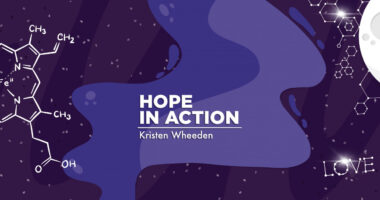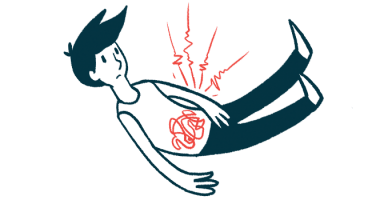How an injury changed the way I view my invisible illness
I finally understood what it's like to have a diagnosis others can see

Every October, the Midwest Alliance for Mindfulness (MAM) hosts a silent retreat in the woods outside of Kansas City, Missouri. For five days, I volunteered not to speak. I knew it would be difficult, but nothing prepared me for what would actually happen.
We arrived on Sunday afternoon to settle into our cabins, and then jumped into group meditation. Silence would commence the following morning.
“I’m connecting with my inner child this week,” I informed my friend Jennifer as we unrolled our yoga mats. Earlier that day, I’d found a slide going down a nearby hill.
“I love that!” she gushed.
On Monday evening, we ate creamy vegan pasta. The only sounds in the dining hall were of forks gently scraping against bowls. After dishes were done, Jennifer followed me outside to the break in the trees where wooden steps led to a black, plastic culvert slide.
I raised my eyebrows at her as if to say, “This one’s for little Claire!” After setting up at the top of the slide with my feet out in front of me, I took off. The wind tossed my hair and my mouth peeled open in a smile. I didn’t know how fast I was going.
My feet hit the ground one after another, but I couldn’t catch myself. The next thing I knew, I’d belly-flopped off the landing platform. My body was ultimately stopped by the cold, hard earth. My right hip crashed onto the ground, quickly followed by the palm of my right hand, and then my face.
Finding peace with my body
In fall 2020, I took a vow to meditate for half an hour every day for eight weeks. The John Stoddard Cancer Center in Des Moines, Iowa, gifted its oncology and hematology patients scholarships to a mindfulness-based stress-reduction course online. Completing the class is the single best action I’ve taken to address my mental health.
Living with a rare, chronic, and invisible illness like acute hepatic porphyria comes with deep uncertainty. I used to live in a state of constant anxiety, preoccupied with when the next attack would hit and what that would mean for my future plans. Enduring medical gaslighting and judgment caused me to feel a deep sense of guilt, as if my illness were somehow my fault. I wore the shame like a corset, tightening around my chest until my breath came out in gasps.
The tension around my rib cage loosened after five weeks of meditation and classes among others who know what it’s like to live in painful, uncomfortable bodies. For the first time since my pain started more than two decades ago, I felt safe in my body. Living in the present moment meant I wasn’t concerned with what might happen next. I found that I could also be more accepting and compassionate regarding my symptoms.
At my first MAM retreat last year, I found a profound sense of peace, safety, and belonging. I made a promise to myself to participate in an extended silent retreat annually, as I am able. I view it as a part of my yearly mental health maintenance protocol.
Becoming visible
The morning after my accident, I slept in and missed breakfast. I looked in the mirror and didn’t recognize the face looking back. Painful abrasions where I’d landed on my lip and chin bloomed in angry reds and pinks. They were already starting to scab and were grotesquely swollen. A deep cut outlined the bottom of my left eye, and my right was bruised in a raccoon mask of purplish red.
My arms and hands were sore where I’d tried to catch myself. Worst of all was the neck pain at the base of my skull, radiating up into my head. I suspected a whiplash injury and was using ice on the surrounding inflamed tissue.
I cleaned the open wounds on my hand and hip, replacing them with fresh bandages. I considered staying in my room all day, hidden from the questioning stares and pitying glances of others. I brushed my long hair forward, in an effort to cover my black eye and chin. Eventually, I held an ice pack to my face and walked to the common room to sit quietly with the group.
Across the circle, a woman looked at me in sympathy. Without saying a word she placed her hands over her heart. In that instant, I understood the difference between pity and empathy. My own self-judgment was unfairly projecting pity onto this group of people I barely knew.
“Can we get you anything?” the facilitator whispered to me at break.
I shook my head and smiled with one side of my mouth. I live every day in invisible pain, but I never appreciated the autonomy I have in disclosing my illness to others. That day, I learned what it’s like having a diagnosis others can see.
Note: Porphyria News is strictly a news and information website about the disease. It does not provide medical advice, diagnosis, or treatment. This content is not intended to be a substitute for professional medical advice, diagnosis, or treatment. Always seek the advice of your physician or other qualified health provider with any questions you may have regarding a medical condition. Never disregard professional medical advice or delay in seeking it because of something you have read on this website. The opinions expressed in this column are not those of Porphyria News or its parent company, BioNews, and are intended to spark discussion about issues pertaining to porphyria.








Comments